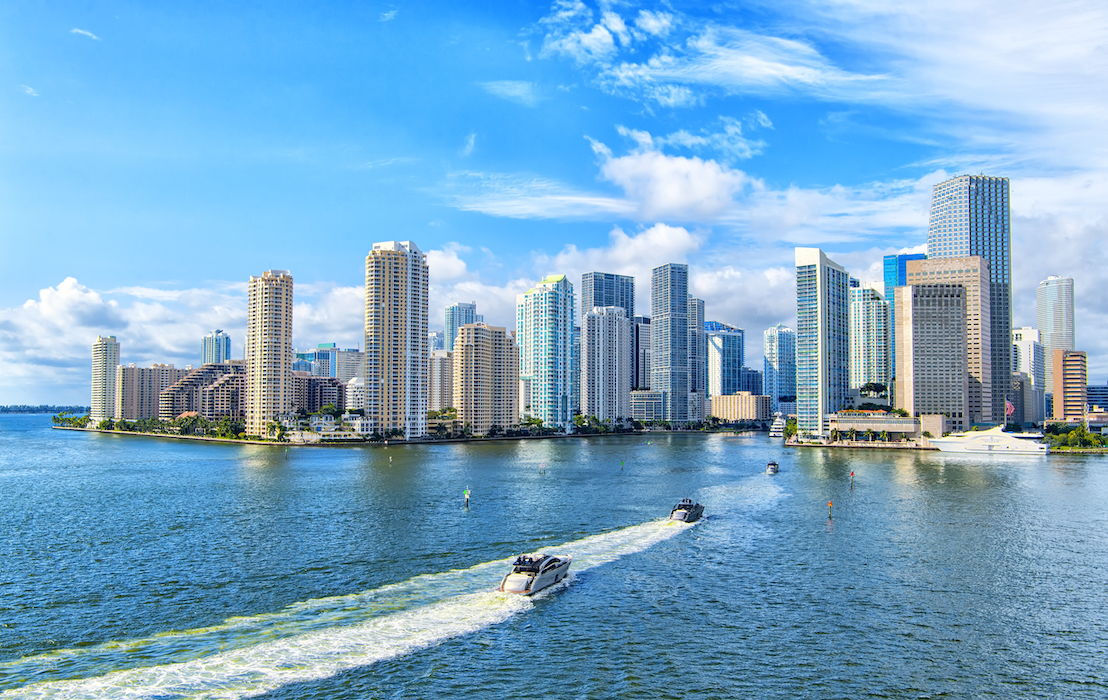How Miami Became an Architectural Hub
While the urban myth prevails that new buildings can’t look good, Miami shows it is possible through economic growth and limited regulation.

There’s a common trope among growth critics—and even many urbanists—that all new development is ugly and soulless. But architectural trends in one of America’s top metros contradicts that narrative. Miami has been one of America’s fastest-growing metros, nearly doubling its population since 1980. With this growth has come the construction of many creative buildings, including a rapid emergence of high rises regionwide, but namely in Miami’s central business district. Contrast this with America’s legacy cities, such as New York and Chicago, which used to build great skyscrapers but now largely forbid new ones.
Miami is catching up with these cities architecturally through a mix of fast growth, permissive zoning, and a unique Latin culture, creating a more inventive environment than in other metros where stringent design review and community input limit dynamism.
From the mid-20th century on, Miami has been a hub of good architecture. The city and metro’s fabric is characterized by traditional Art Deco beach design, particularly in Miami Beach, but also a distinctive, newer style of architecture known as Miami Modern. Examples include the Waterside Hotel and The Drake Villas.
But a less-discussed Miami subgenre is called “tropical modern” architecture. Tropical modern, according to covetedition.com, is a trend that emerged in the 1950s focusing on optimizing cooling and sourcing materials in tropical destinations. Miami megadeveloper Jorge Perez, who builds the style, once told me that it is like the generic modernism promoted by Mies van der Rohe, but less austere and with more design touches like unusual balcony layouts. One sees lots of tropical modern in Asia and Latin America, and because Miami is the de facto U.S. capital for the latter, it has bled into local designs.
The Brickell skyline. (Image Credit: Canva.)
One of the city’s main hubs of tropical modern architecture is Brickell, a newer financial district on the outskirts of its traditional downtown. Formerly a low-density residential neighborhood, its profile began to change into a commercial district in the 1990s when a developer built a 51-story residential building. The skyscrapers have shot up since - dozens within 1-square mile - which simply would not be allowed at that pace in one neighborhood in America’s legacy cities.
One of these is Perez’ Icon Brickell, a 3-tower residential primary complex that includes a hotel. The multistory buildings are framed by an entryway inspired by Easter Island, and house 1,800 units.
The Icon Brickell. (Image Credit: Canva.)
Outside of Brickell, the One Thousand Museum development (also residential, named for a nearby park) is found on Biscayne Boulevard. Completed just two years ago, the building is noted for its distinctiveness, and has been described by a PBS documentary as one of the most complex ever built. The structure included materials shipped from Dubai known as glass fiber reinforced concrete.
One Thousand Museum. (Image Credit: Godsfriendchuck, Wikimedia Commons (License).)
Other interesting skyscrapers can be found elsewhere in Miami and many of its suburbs. This high-rise boom occurred in the conspicuous absence of land use regulations common in more mature cities. Much of Miami’s greater downtown has very generous height limits, zoned for up to 80 stories. In Brickell as of 2017, the maximum allowable height was 1,049 feet - as South Florida Business Journal writes, “in the U.S., only New York, Chicago, Los Angeles and San Francisco would have taller towers.”
Allowable built area is also generous, with allowable footprints including buildings exceeding 29,000 feet. The main barrier to tall construction in the city appears to be Federal Aviation Administration height limits owing to Miami International Airport. But overall, Miami’s liberal attitude towards height and bulk means lots of skyscrapers get built, and that architects have wiggle room to be creative.
By contrast, to build a tower in New York City is an endurance test that can require years of fighting community boards and lawsuits. Even when buildings are constructed, they must contend with stringent design review and zoning rules. In fact, the much-maligned narrow skyscrapers that have cropped up in the last decade are a consequence of zoning rules that restrict lot coverage. Meanwhile, in legacy cities that cling particularly to preservationism, it is hard to go vertical at all. Philadelphia, for instance, even restricts the height of its rowhouses.
Consequently, other American cities’ skylines mainly rest on past glory, with current architects less able to focus on innovation than on compliance. But in Miami it is the opposite, as lax regulations allow for unique construction…in the 21st century.
FTX Arena. (Image Credit: Canva.)
Beyond zoning and design review, other land use regulations that interfere with development elsewhere aren’t present downtown. For instance, in 2009 the city abolished minimum parking requirements there (on-site parking stalls can significantly eat into a project’s revenue and limit what can be done with it architecturally). Like clockwork, this caused parking-free towers to go up downtown.
Unfortunately, the city may bring the minimums back, given recent comments by some authorities. Other neighborhoods, such as Wynwood, and the nearby city of Miami Beach, subject buildings to design review. And there is growing advocacy to protect the region’s unique architecture with the creation of an anti-demolition ordinance for certain structures.
Subscribe Today
Get daily emails in your inbox
Hopefully this preservationist impulse - while good up to a point - does not become so strong that Miami parrots the same anti-development stagnation facing other metros. The city achieved its unique look in the first place by embracing growth and keeping government bureaucracy at bay.
This article featured additional reporting from Market Urbanism Report content staffer Ethan Finlan.
This New Urbanism series is supported by the Richard H. Driehaus Foundation. Follow New Urbs on Twitter for a feed dedicated to TAC’s coverage of cities, urbanism, and place.
Comments